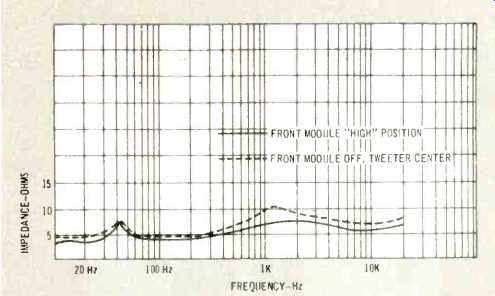
MANUFACTURER'S SPECIFICATIONS
Speaker Components: Three 1-in. cone tweeters; two 8-in. bass, and one 6-in. bass.
Magnet Weight: Total of 3 lbs. per speaker.
System Type: Acoustic suspension for both woofers and tweeters.
Power: Minimum of 35 watts at 4 ohms; maximum of 150 watts at 4 ohms (rms).
Frequency Response: 36 to 17,000 Hz 75 dB.
Size: 24 by 16 by 1 5 inches.
Weight: 60 lbs.
Price: S 249.00.
The EPI 601 is a little unusual in that it uses both forward and rear facing speakers to give the effect of a large sound source.
A total of six speakers are used-two 8-in., one 6-in. and three 1-in. wide angle cone tweeters. The 6-in. unit and a tweeter are mounted on the front and the other two pairs "fire" from the rear-angle sides. A three-position switch controls the input to the front module and a variable control adjusts input to the three tweeters. Crossover is around 1800 Hz and, following EPI practice, roll-off is purely mechanical (i.e. by appropriate cone design) and no inductors are used.
Measurements

Fig. 1--Frequency response taken with one-third octave pink noise. Curve A
was taken with the front module control at "high" and curve B with
the control at "normal."
Figure 1 shows the response taken with one-third octave pink noise, measured with the system placed 12 inches from a wall. Response with the front module level switch at "high" is shown at A and with the switch at "normal" at B. Off-axis response at 45 degrees was not substantially different so is not shown. Figure 2 shows the tone-burst responses at 100 Hz, 1 kHz and 5kHz, and the impedance characteristics are shown in Fig. 3. It will be noticed that the rise at resonance is quite small-partly due to the parallel operation. The actual system resonance was commendably low at 40 Hz. White noise tests showed very little coloration indeed and in this respect the 601 must be ranked with the best. Figure 4 gives the distortion measurements at inputs of 10 and 20 watts. Output was well maintained down to 30 Hz and no less than 120 watts was required before frequency doubling became evident at 40 Hz. This is mainly due to the long traverse voice coils fitted on the bass units-a linear excursion of a half inch is claimed. Sensitivity is slightly below average and an amplifier giving at least 40 honest watts per channel is recommended for best results.

Fig. 2--Tone burst responses at A, 100 Hz; B, 1 kHz and C, 5 kHz.

Fig. 3--Impedance characteristics.

Fig. 4--Low frequency distortion at 10W and 20W.
Listening Tests
The actual listening tests took place before the lab measurements were made: this of course avoids any prejudgments based on the figures. The systems were tried out in various positions but finally ended up on stands about 20 inches from the floor and some 12 inches from the walls near the corners. The amplifier used was a Sony 1130 which puts out about 80 watts per channel. The room size was about 25 by 16 feet, fairly heavily damped. The first impression was a lack of coloration and a smoothness in overall sound-confirmed later by the response curves and white noise tests. Once the optimum positions were found, it was possible to get a good stereo image. As stated previously, this kind of system which depends on wall reflections is probably more critical in positioning than most. EPI states in their leaflet that the 601 should be kept at least 12 in. from shelves and 15 in. on either side should be kept free of large solid objects. It can be placed directly against a wall, although in our listening room the preferred position was a few inches away. Best position for the treble control, which regulates all three tweeters, was at maximum. We found the best position for the front module control switch was at "high"--in other words, with the highest ratio of direct sound.
To quote from the EPI leaflet, "Most of the sound is reflected off the rear and side walls of the room. Only a small percentage of the sound comes directly to the listeners.
This direct sound provides the information necessary for proper stereo realism; the indirect sound adds the fullness and body to the music, and together they achieve close to concert hall realism." It is only fair to say that some experts disagree with this philosophy but the subject will be discussed at some length in a later issue. It is sufficient to state here that very directional speaker systems give a sharp well-defined stereo image over a small listening area, while so-called omni-directional systems tend to produce a diffuse image over a much wider listening area. The 601 is not described as an omni-directional system and really combines some features of both concepts.
Overall sound quality was excellent with smooth highs and a tight, well-controlled bass. EPI sound has been criticized in some quarters as "lacking in warmth." We disagree; the warmth should be provided by the program source, not the loudspeaker.
Summing up, the EPI 601 can be recommended to the attention of those who want a reasonable size system with high power handling capacity, low coloration and better than average performance. It will particularly interest those who like a spacious kind of sound.*
-T.A. & G.W.T.
*We understand that the 601 has now been superseded by the 602. The only difference is that the three-position switch has been replaced by a variable control. -Ed.
(adapted from Audio magazine, Jan. 1973)
Also see:
EPI Stat 450 Speaker (Feb. 1987)
Epicure Model EPI-100 Speaker System (May 1970)
Onkyo Model 20 speaker system (Jan. 1973)
ESS Mk VII Speaker System (Equip. Profile, Jan. 1973)
= = = =